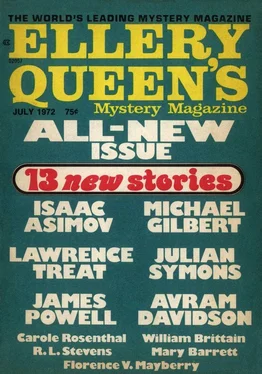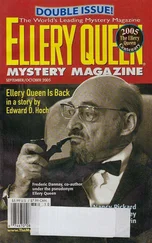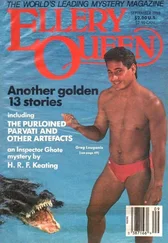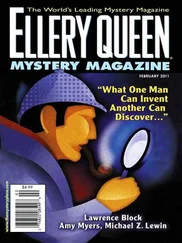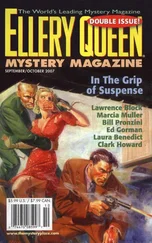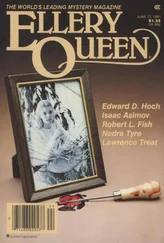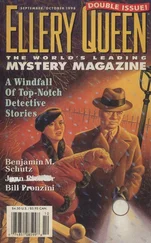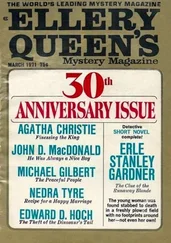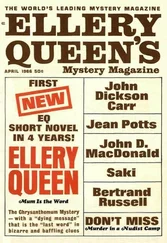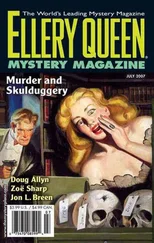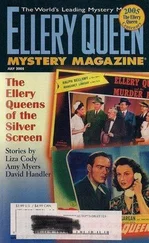Ellery Queen’s Mystery Magazine, Vol. 60, No. 1. Whole No. 344, July 1972
Здесь есть возможность читать онлайн «Ellery Queen’s Mystery Magazine, Vol. 60, No. 1. Whole No. 344, July 1972» весь текст электронной книги совершенно бесплатно (целиком полную версию без сокращений). В некоторых случаях можно слушать аудио, скачать через торрент в формате fb2 и присутствует краткое содержание. Город: New York, Год выпуска: 1972, Издательство: Davis Publications, Жанр: Классический детектив, на английском языке. Описание произведения, (предисловие) а так же отзывы посетителей доступны на портале библиотеки ЛибКат.
- Название:Ellery Queen’s Mystery Magazine, Vol. 60, No. 1. Whole No. 344, July 1972
- Автор:
- Издательство:Davis Publications
- Жанр:
- Год:1972
- Город:New York
- ISBN:нет данных
- Рейтинг книги:4 / 5. Голосов: 1
-
Избранное:Добавить в избранное
- Отзывы:
-
Ваша оценка:
- 80
- 1
- 2
- 3
- 4
- 5
Ellery Queen’s Mystery Magazine, Vol. 60, No. 1. Whole No. 344, July 1972: краткое содержание, описание и аннотация
Предлагаем к чтению аннотацию, описание, краткое содержание или предисловие (зависит от того, что написал сам автор книги «Ellery Queen’s Mystery Magazine, Vol. 60, No. 1. Whole No. 344, July 1972»). Если вы не нашли необходимую информацию о книге — напишите в комментариях, мы постараемся отыскать её.
Ellery Queen’s Mystery Magazine, Vol. 60, No. 1. Whole No. 344, July 1972 — читать онлайн бесплатно полную книгу (весь текст) целиком
Ниже представлен текст книги, разбитый по страницам. Система сохранения места последней прочитанной страницы, позволяет с удобством читать онлайн бесплатно книгу «Ellery Queen’s Mystery Magazine, Vol. 60, No. 1. Whole No. 344, July 1972», без необходимости каждый раз заново искать на чём Вы остановились. Поставьте закладку, и сможете в любой момент перейти на страницу, на которой закончили чтение.
Интервал:
Закладка:
“St. John had a strong suspicion that La Flama had killed Evelyn, but he had no evidence, no proof. So after the murder and before he delivered the painting, he painted in her name, hoping that between her guilt and her deeply ingrained peasant’s superstition she’d eventually get scared and give herself away.”
“But he didn’t paint her name in,” I say. “The letter was a W — remember?”
“A W is an M,” Rogers says, “when it’s. upside down. And that’s how St. John painted it — upside down. Because everything he ever did was evasive and roundabout. He was afraid to accuse La Flama openly — he could only bring himself to do it indirectly, upside down.”
“M? Of course! La Flama’s real name — Marguerita.”
And I make a notation on my pad to instruct Jacobus to paint in an M so that people can read it clearly. And when the meaning of the initial is revealed, won’t that increase our attendance!

The African Tree Beavers
by Michael Gilbert { © 1972 by Michael Gilbert. }
Hip, hip, hooray! Messrs. Calder and Behrens, the two quiet, dignified, seemingly sedate English country squires, are back and once again pursuing their undercover roles. The two master counterspies are looking for a secret agent, planted in a “primitive” Norfolk village, in an atmosphere of superstitions, coincidences, animal magnetism, miracles, menace, and mystery ... This is the first of a new series...
Like many practical and unimaginative men, Mr. Calder believed in certain private superstitions. He would never take a train which left at one minute to the hour; he distrusted the number 29; and he refused to open any parcel or letter on which the stamp had been fixed upside down. This, incidentally, once saved his life when he refused to open an innocent-looking parcel bearing the imprint of a bookseller from whom he had made many purchases in the past but which proved, on this occasion, to contain three ounces of tritoluene and a contact fuse. Mr. Behrens sneered at the superstition, but agreed that his friend had been lucky.
Mr. Calder also believed in coincidences. To be more precise, he believed in a specific law of coincidence. If you heard a new name, or a hitherto unknown fact, twice within twelve hours you would hear it a third time before another twelve hours was up. Not all the schoolmasterly logic of Mr. Behrens could shake Mr. Calder in his belief.
If challenged to produce an example, Mr. Calder would cite the case of the Reverend Francis Osbaldestone. The first time he heard the name was at eleven o’clock one night, at the Old Comrades Reunion of the Infantry Regiment with which he had fought for a memorable eight months in the Western Desert in 1942. He attended these reunions once every three years. His real interest was not in reminiscence of the war, but in observation of what had taken place since. It delighted him to see that a Motor Transport Corporal, whom he remembered slouching round in a pair of oily denims, should have become a prosperous garage proprietor, and that the Orderly Room Clerk, who had sold places on the leave roster, had developed his talents, first as a bookmaker’s runner and now as a bookmaker; and that the God-like Company Sergeant Major should have risen no higher than commissionaire in a block of flats at Putney, who would be forced, if he met him in ordinary life, to call his former clerk, “sir.”
Several very old friends were there. Freddie Faulkner, who had stayed on in the army and had risen to command the Battalion, surged through the crowd and pressed a large whiskey into his hand. Mr. Calder accepted it gratefully. One of the penalties of growing old, he had found, was a weak bladder for beer. Colonel Faulkner shouted, above the roar of conversation, “When are you going to keep your promise?”
“What promise?” said Mr. Calder. “How many whiskies is this? Double or triple?”
“I thought I’d get you a fairly large one. It’s difficult to get near the bar. Have you forgotten? You promised to come and look me up.”
“I hadn’t forgotten. It’s difficult to get away.”
“Nonsense. You’re a bachelor. You can up-sticks whenever you like.”
“It’s difficult to leave Rasselas behind.”
“That dog of yours? For God’s sake. Where do you think I live? In Hampstead Garden Suburb? Bring him with you. He’ll have the time of his life. He can chase anything that moves, except my pheasants.”
“He’s a very well-behaved dog,” said Mr. Calder, “and does exactly what I tell him. If you really want me—”
“Certainly I do. Moreover I can introduce Rasselas to another animal lover. Our rector. Francis Osbaldestone. A remarkable chap. Now get your diary out and fix a date—”
It was at ten o’clock on the following morning when the name cropped up next. Mr. Calder was stretched in a chair in front of his fire, his eyes shut, nursing the lingering remains of a not disagreeable hangover. Mr. Behrens was in the other chair, reading the Sunday newspapers. Rasselas occupied most of the space between them.
Mr. Behrens said, “Have you read this? It’s very interesting. There’s a clergyman who performs miracles.”
“The biggest miracle any clergyman can perform nowadays,” said Mr. Calder sleepily, “is to get people to come to church.”
“Oh, they come to his church all right. Full house every Sunday. Standing room only.”
“How does he do it?”
“Personal attraction. He’s equally successful with animals. However savage or shy they are, he can make them come to him and behave themselves.”
“He ought to try it on a bull.”
“He has. Listen to this. On one. occasion a bull got loose and threatened some children who were picnicking in a field. The rector, who happened to be passing, quelled the bull with a few well-chosen words. The children were soon taking rides on the bull’s back. ”
“Animal magnetism.”
“I suppose, if you’d met St. Francis of Assisi, you’d have said, ‘animal magnetism’.”
“He was a Saint.”
“How do you know this man isn’t?”
“He may be. But it would need more than a few tricks with animals to convince me.”
“Then what about miracles? On another occasion the rector was wakened on a night of storm by an alarm of fire. The verger ran down to the rectory to tell the rector that a barn had been struck by lightning. The telephone line to the nearest village with a fire brigade was down. The rector said, ‘Not a moment to lose. The bells must be rung. ’ And as he spoke the bells started to ring. ”
Mr. Calder snorted.
“It’s gospel truth. Mr. Penny, the verger, vouches for it. He says that by the time he got back to his cottage, where the only key of the bell chamber is kept, and got across with it to the church, the bells had stopped ringing. He went up into the belfry. There was no one there. The ropes were on their hooks. Everything was in perfect order. At that moment the fire brigade arrived. They had heard the bells and were just in time to save the barn.”
Mr. Calder said, “It sounds like a tall story to me. What do you think, Rasselas?” The dog showed his long white teeth in a smile. “He agrees with me. What is the name of this miracle worker?”
“He is the Reverend Francis Osbaldestone.”
“Rector of Hedgeborn, in the heart of rural Norfolk?”
Читать дальшеИнтервал:
Закладка:
Похожие книги на «Ellery Queen’s Mystery Magazine, Vol. 60, No. 1. Whole No. 344, July 1972»
Представляем Вашему вниманию похожие книги на «Ellery Queen’s Mystery Magazine, Vol. 60, No. 1. Whole No. 344, July 1972» списком для выбора. Мы отобрали схожую по названию и смыслу литературу в надежде предоставить читателям больше вариантов отыскать новые, интересные, ещё непрочитанные произведения.
Обсуждение, отзывы о книге «Ellery Queen’s Mystery Magazine, Vol. 60, No. 1. Whole No. 344, July 1972» и просто собственные мнения читателей. Оставьте ваши комментарии, напишите, что Вы думаете о произведении, его смысле или главных героях. Укажите что конкретно понравилось, а что нет, и почему Вы так считаете.
